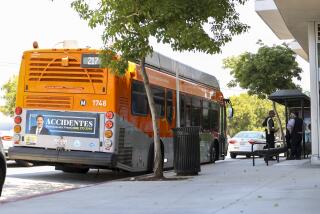MTA Outlines Traffic Plan for Antelope Valley
- Share via
Northern Los Angeles County, facing an explosion of new houses and industrial development, needs a new freeway, improved highways, and better bus and train service at a cost of $5.4 billion, Metropolitan Transportation Authority staff members have concluded.
“We don’t have anywhere to go,” said Brian Lin, project manager for the north county highway study. “Take the 5. That’s already jammed. The 14 is the only one in the Antelope Valley area. And going east-west, you can only go along the 138, a two-lane roadway.”
The study, which the MTA board will consider Thursday, presents a comprehensive transportation plan for the region and offers some new ideas, such as reversible carpool lanes on the Antelope Valley Freeway to accommodate the flow of cars during morning and evening rush hours.
It also proposes upgrading some traffic-signaled expressways to ramp-controlled freeways to handle the growth of airports and new homes at developments such as Centennial Ranch near the Kern County line.
Undeveloped land and relatively inexpensive housing have made northern Los Angeles County -- especially the Antelope Valley -- one of the fastest-growing areas in Southern California.
According to the Southern California Assn. of Governments, Santa Clarita will grow by 50% to 232,000 residents by 2030; Lancaster will more than double to 260,000; and Palmdale will nearly triple to 337,000.
Many who move to the area will continue to work elsewhere, straining the highways. Currently, the Greater Antelope Valley Economic Alliance estimates that about 54,000 commuters leave the Antelope Valley every morning, heading mostly to Santa Clarita, the San Fernando Valley and downtown Los Angeles.
“We have major problems already,” said Connie Worden-Roberts, chairwoman of the transportation committee of the Santa Clarita Valley Chamber of Commerce. “It’s congested every day.”
Cars now inch along the Golden State Freeway at an average of 26 mph during rush hour and could slow to 11 mph by 2020 unless new roads are built, the association of governments said. Average rush hour traffic on the Antelope Valley Freeway could slow from 18 mph to just 9.5 mph.
The north county study was requested several years ago by local officials frustrated by congestion on the Antelope Valley Freeway. The MTA agreed to examine that freeway corridor -- but also enlarged the study to include the network of highways in the 2,000-square-mile region.
The biggest challenge now is to find money to fund those projects, said Frank C. Roberts, chairman of the MTA board and mayor of Lancaster. The MTA already has a waiting list of projects on hold for lack of funding. “The state is in such a bad position with money flow,” Roberts said.
In the MTA study, highway-related improvements account for almost all of the recommendations, costing $4.8 billion, while transit improvements would cost $600 million.
The MTA investigated various ways to solve congestion and safety issues, including more commuter trains, buses and light rail. “We threw those out,” Lin said. “They were not cost effective and the ridership was very low.”
By 2010, the MTA recommended these improvements:
* Add a high-occupancy vehicle lane and a truck lane in each direction on the Golden State Freeway from the Antelope Valley Freeway to Calgrove Boulevard and a high-occupancy vehicle lane in each direction from there to the Santa Paula Freeway.
* Create three lanes in each direction on the Antelope Valley Freeway between Sand Canyon Road in Santa Clarita and Rancho Vista Boulevard in Palmdale.
* Complete work to add a lane on each side of Pearblossom Highway from Avenue T to the San Bernardino County line.
By 2025, the MTA recommended these improvements:
* Construct a new 160-mile High Desert Corridor freeway to connect the Golden State and Mojave freeways.
* Double the number of lanes, to eight, in each direction on the Golden State Freeway between the Antelope Valley and Santa Paula freeways.
* Triple the capacity of Metrolink trains between the Antelope Valley and Los Angeles, with more departures and more rail cars in peak hours.
MTA officials said they worked hard to build consensus for the plan. A technical advisory committee with representatives from agencies such as Caltrans and the California Highway Patrol met monthly for about 2 1/2 years to review the report. The authority conducted briefings, town hall meetings and more than 75 interviews with local officials.
“We’re pretty happy with the result,” said Jim Ledford, mayor of Palmdale and chairman of the North County Transportation Coalition.
In particular, he praised the reversible lanes, which he said would provide “immediate relief without the cost of building new roads.”
More to Read
Sign up for Essential California
The most important California stories and recommendations in your inbox every morning.
You may occasionally receive promotional content from the Los Angeles Times.













